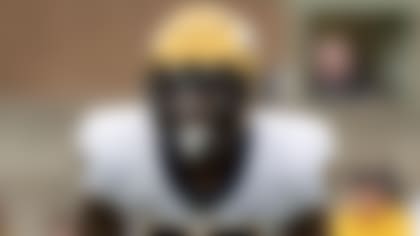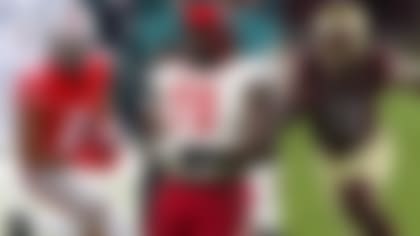With the 2016 NFL Scouting Combine upon us, Bucky Brooks is ranking the top prospects at key positions. Today's focus: offensive linemen.
Pro comparison:Jason Peters.
Strengths: Dancing bear on the edge with an outstanding combination of size, athleticism and technical skills. Tunsil is a polished left tackle with all of the tools to play at a Pro Bowl level early in his NFL career. He shines in pass protection, exhibiting excellent balance and body control while snuffing out edge rushers in isolated matchups. In addition to working well in one-on-one matches, Tunsil shows exceptional awareness and football intelligence sorting out rushers on stunts, games and blitzes. Considering his sound footwork, fundamentals and high football IQ, it is not surprising that he only allowed two sacks in 29 career games at Ole Miss. As a run blocker, Tunsil possesses the strength, power, agility and movement skills to shine in a zone- or power-based scheme. He consistently moves defenders off the ball on plays directed to his side, but he also shows the athleticism and body control to cut off second-level defenders as a back-side blocker. With coaches and scouts coveting natural left tackles with light feet, polished technique and nasty dispositions, it is easy to see why Tunsil ranks as the top offensive tackle in the class.
Weaknesses: There's no disputing Tunsil's talent and potential as arguably the best offensive tackle prospect to enter the draft in the past five years. He has all of the tools to be a great player from Day 1 -- yet, he will need to refine his technique to consistently handle the elite NFL pass rushers that routinely hunt the quarterback from RDE. Thus, he must eliminate the jitters that lead to false-start penalties and learn how to quickly retreat from his stance to eliminate the favorable angles on "wide-nine" rushes. From a character standpoint, Tunsil must address his NCAA-imposed suspension to clear up any concerns about his ability to toe the company line within the locker room. Scouts will also scrutinize Tunsil's medical history to see if the big-bodied athlete will have durability woes at the next level.
Pro comparison:Ryan Clady.
Strengths: Big, athletic offensive tackle with light feet and exceptional movement skills. Stanley not only has the requisite physical tools to shine as a pro, but he has a combination of size, length and athleticism few offensive tackles can match on the perimeter. Measuring 6-foot-6, 315 pounds, Stanley is a natural left tackle with the balance, body control and lateral quickness to mirror shifty rushes on the edges. He displays one of the best kick-slides you'll see from a young player, which allows him to neutralize pass rushers with explosive first-step quickness. Stanley shows exceptional strength and anchor ability stopping rushers on bull-rush attempts. As a run blocker, Stanley is an athletic "people mover" at the point of attack. He knocks defenders off the ball and displays the competitive grit coaches covet when finishing blocks. Considering Stanley's experience on both edges (26 starts at left tackle; 13 starts at right tackle) and his high football IQ, the Notre Dame standout is a transcendent top-five talent capable of earning honors early in his career.
Weaknesses: It is hard for tall edge blockers to consistently play with exceptional balance, body control and pad level against power rushers. Despite Stanley's solid overall game, he needs to diligently work on his anchor and set to ward off rushers intent on using power maneuvers to get to the quarterback. A few maulers have enjoyed some success driving him into the quarterback's lap; at the next level, that could lead to strip-sacks and turnovers.
Pro comparison:Andrew Whitworth.
Strengths: Blue-collar edge blocker with a gritty demeanor and solid overall game. Conklin is a throwback at the position, exhibiting strong hands and a powerful punch when engaging defenders at the line. He complements this with textbook footwork and fundamentals on the edge. Conklin flashes a quick kick-step to mirror and shadow speed rushers, but he's at his best when utilizing a "short set" and power punch to stone rushers in their tracks. Conklin's aggressive approach makes him a natural tone setter for the offensive line; he could help inspire the kind of rugged mentality from his unit that's essential to long-term success. As a run blocker, Conklin exhibits mauler/brawler traits at the line of scrimmage. He aggressively moves defenders off the ball and displays some nastiness as a finisher. The Michigan State standout routinely left defenders in a "turtle" position (defender on his back with his legs in the air) after driving them several yards downfield. With physical edge players still coveted by proponents of old-school football, Conklin's rugged game should make him a nice fit for a team employing a run-heavy approach.
Weaknesses: For all of Conklin's strengths as an aggressive edge blocker, he is susceptible to losing battles on the perimeter to athletic defenders. He lacks the lateral quickness to handle speed rushers with a wide array of inside-outside counter moves off the corner. Thus, teams can't fully expect Conklin to take on premier rushers consistently without assistance from a tight end or running back. While most young offensive tackles need to play with training wheels early in their career, Conklin's athletic limitations could force the offensive coordinator to alter their plans to make up for the young player's deficiency.
Team fits:New York Giants, Philadelphia Eagles, Detroit Lions, Indianapolis Colts.
Pro comparison:Zack Martin.
Strengths: Polished technician with a rock-solid game and a versatile skill set. Whitehair enters the NFL as an experienced player (51 career starts) capable of thriving at guard or tackle at the next level. Although he lacks impressive physical dimensions, he is a stout blocker at the point of attack. He plays with balance and body control in tight quarters, exhibiting the ability to anchor against power-based maneuvers on passing downs. Whitehair concedes a little ground, but he eventually stops penetration and redirects defenders off their intended line. In the run game, Whitehair is a position blocker adept at working angles to neutralize defenders at the line. He latches onto defenders quickly after the snap and sustains his block until the runner reaches the second level. Given Whitehair's solid skills, particularly within tight quarters, he could shine as solid starter at guard from Day 1.
Weaknesses: Whitehair lacks the lateral quickness and movement skills to play extensively on the edges as a pro. He struggles against explosive pass rushers with elite first-step quickness and movement skills. Thus, Whitehair is better suited to play on the inside, where he can rely on body help from his teammates and minimize his deficiencies by playing within a phone booth. In addition, Whitehair needs to refine his hand placement and technique to better handle rushers with superb hand-combat skills.
Team fits:Minnesota Vikings, Denver Broncos, Indianapolis Colts, Miami Dolphins.
Pro comparison:Anthony Castonzo.
Strengths: Long, rangy edge blocker with workmanlike game and solid fundamentals. Decker doesn't wow observers with his athleticism or fancy footwork, but he consistently wins on the edge, keeping defenders at bay with his superb technique. He stalemates rushers with solid jabs and uses his superior reach to run them past the quarterback. Despite his tall frame, Decker flashes balance and body control when anchoring against power rushers. He drops his weight, sinks his hips and utilizes a wide base to stop penetration. As a run blocker, Decker is at his best working angles to neutralize defenders at the line. Although he doesn't generate a significant push at the line, he latches on quickly and cuts defenders off on the back side. Decker shows better-than-anticipated athleticism and body control on blocks at the second level. He engages defenders and runs his feet through the whistle. With 40-plus games of starting experience at right and left tackle, Decker could step in as an immediate starter as a young player.
Weaknesses: As a taller edge blocker with extraordinary length, Decker is prone to lose battles against low-leverage pass rushers. He doesn't consistently drop his weight quickly enough to neutralize defenders at the line, and his inconsistent anchor is problematic for offensive coordinators intent on leaving their offensive tackles alone in one-on-one matches. Although Decker has won the majority of his battles against elite rushers, the anchor issues could make him a target for rushers with power-based maneuvers featured in his arsenal (see: Khalil Mack's 2013 performance vs. Ohio State, in which he racked up 2.5 sacks, nine tackles and a pick).
Follow Bucky Brooks on Twitter @BuckyBrooks.












